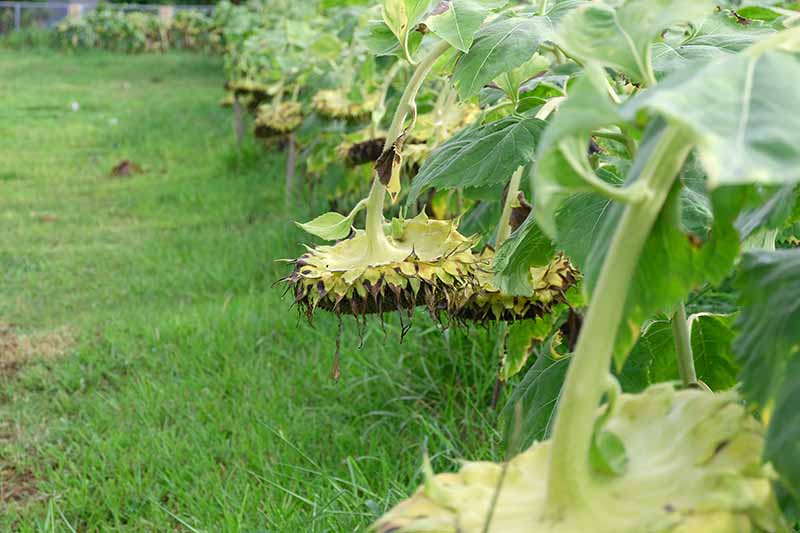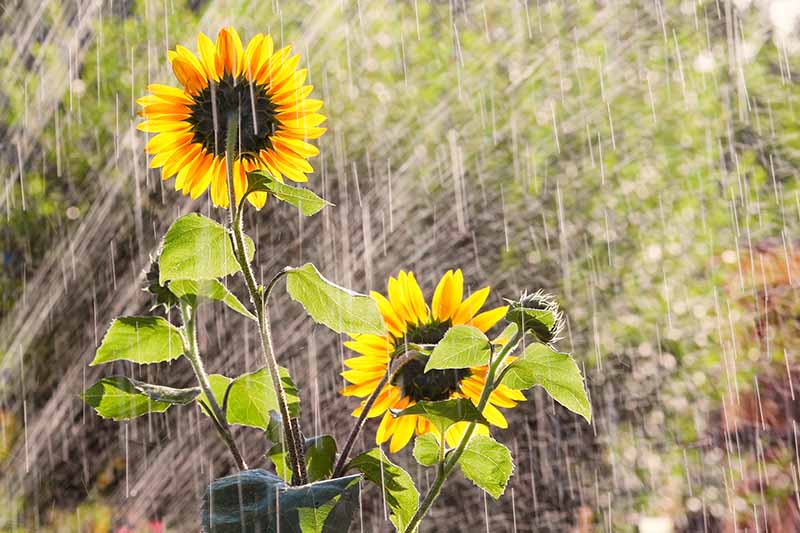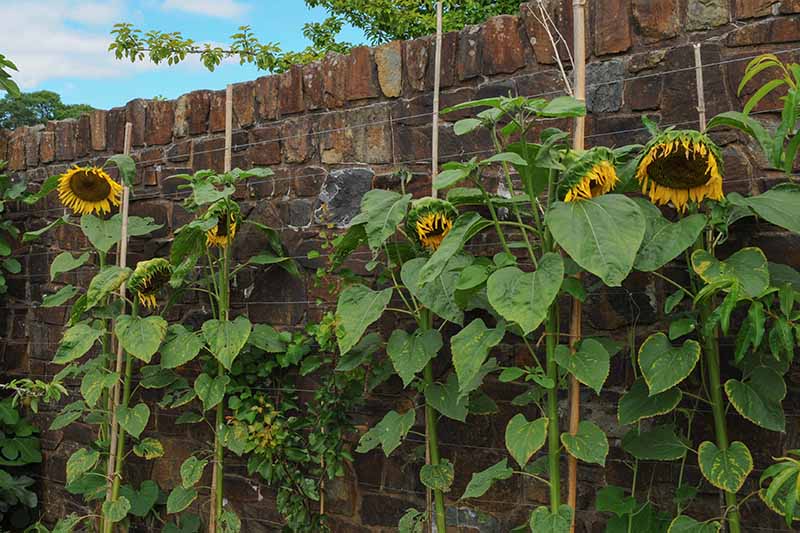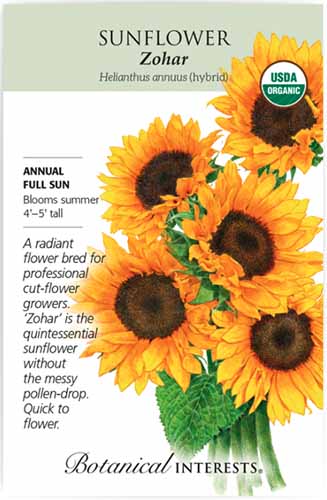Known as “heliotropism,” this trait makes the blooms seem like they’re always looking right at the sun. But sometimes, the opposite happens. Either the blooms or the stalks start to droop or bow over, and seem to be staring at the ground. Whether this occurs when they’re young seedlings or in full flower, it can be alarming. We link to vendors to help you find relevant products. If you buy from one of our links, we may earn a commission. Full disclosure: At least one cause of drooping Helianthus annuus, as these beauties are known botanically, can’t be treated. That is definitely uncool! But I’ll also share some situations where you can revive a slumping sunflower. And I’ll detail some preventive measures as well.
1. Time to Harvest
Honestly, they may not look great, but slumping sunflowers may be a good thing in some circumstances! When the flowers have matured, they form seed heads. It’s in their nature to tilt downwards, so the soil will catch the ripe seeds as they drop. When they’ve been otherwise healthy and you’re growing single-stem varieties for floral arrangements, seeds to eat, or as a county fair “largest” entry, fear not. Those bowing-over stalks probably just mean your sunny friends are at the end of their life cycle. To double check that your lovely flowers don’t have some other ailment, like a fungus that could live on to infect next year’s garden, take a look at the back of the heads. If they’ve turned from green to yellow-brown and the front reveals the tips of tightly packed seeds, yep, they’re ripe for the picking. Solution: Even when they’re packed full of seeds, some gardeners don’t like the look of giant droopy stalks on their landscape or in their wonderful cottage garden, and I don’t blame them. If you’re one of these growers, I have several suggestions. First, you can always be careful to cut the flowers before the heads begin to form seeds. In fact, for floral arrangements, it’s best to cut the main stem right before the flower head begins to bloom, leaving at least a foot of the stalk intact. It will burst into beauty indoors, and the process encourages side shoots, too. Another idea is to plant the seeds for longer-growing varieties a little later than usual. That way, when they begin to droop, it won’t be in the middle of your carefully planned summer landscape. That way, if they start bowing down in anticipation of the harvest in late summer or even early fall, you won’t be looking at bowed heads for long before the first frost. Finally, you can always consider planting branching varieties with smaller blooms instead. They’re easier to deadhead, and the droop is not at all noticeable when they’re finishing up their growing season.
2. Transplant Shock
Earlier in the growing game, when they’re still just a few inches tall, transplant shock may cause sunflower seedlings to bend, wilt, or slump. Naturally, this doesn’t happen with seeds you sow directly into the garden. But these sun worshipers are well-known for hating to have their roots disturbed. Transplanting them from a plastic container can bend or snap that precious taproot. Once that happens, the seedlings typically begin to droop, and they die very quickly after that. Growing seedlings to transplant may also give them a chance to become rootbound in a small container, which is another problem with no cure. If the roots are too big, they can’t draw up water, and the whole seedling will quickly languish. Also, if you start the seeds indoors, it’s really easy to end up with bent over, wilted plants once you get your seedlings in the ground, unless you take a few extra days to gradually get them used to stronger sunlight or warmer temperatures. If you planted them without that period of “hardening off,” the transplant shock that results is probably the explanation for your languishing H. annuus plants. Solution: Instead of trying to get a jump on the season by starting seeds indoors, wait for the weather to warm up enough to plant seeds directly outdoors instead. You may be shaking your head at this point, thinking, “Of course, I would if I could.” If your only option is to transplant sunflowers, I sympathize. But anyone who really needs those extra days to be able to grow sunflowers before the weather gets too cold in your USDA Hardiness Zone does still have a little wiggle room. Finally, if getting a jump on the growing season is crucial, minimize the risk of slumping or drooping seedlings by planting the seeds in peat pots or other biodegradable options, like toilet paper tubes cut into shorter sections. ‘ProCut’ Seeds are available from True Leaf Market. Another option is to start the seeds inside, but in a container that can be brought outdoors when the weather is warm enough. This eliminates the issue of transplant shock, since you’ll keep the blooms in the same container for their entire growth cycle. That way, you can transplant the seedlings, pot and all, when the time is right. It’s no substitute for direct seeding, but planting starts in biodegradable pots may help to keep a higher percentage of them upright and thriving for the entire season.
3. Not Enough Water
If your big ol’ sunflower seed heads are drooping, that is usually a signal of the end of their growth cycle, not a sign of dehydration. But younger seedlings, and even midsize plants, may hunch over because they’re not getting enough water. Let’s talk about container-grown sunflowers first, since they’re the most susceptible. When you’ve planted in a pot without ample drainage, or with poor soil that doesn’t retain water, there’s a good chance that any sad looking seedlings are just pot bound, or have constricted roots due to hard soil. Either way, they’re probably thirsty. To test this, give the plant about a quart of water right at the soil line, and then watch. If it trickles out of the bottom quickly, the seedling is probably too big for the container, or the soil may have hardened and won’t allow water to reach the roots. Older and younger sunflowers may also be dehydrated. Consider this possibility if the weather has been dry and you didn’t offer supplemental water. Solution: If you have determined the soil is too poor and it’s gotten hard, you can try to repot the entire contents of your current container inside a larger container filled with superior soil. Water it thoroughly, and hope for the best. When your tiny potted seedlings are dry and droopy but haven’t outgrown their container, take the time to do a careful job of deep watering. With the plant positioned upright, plunge the whole pot into a large bucket of water. Lower the container until the water runs over the rim, but not so deep that the leaves go underwater. Keep holding the pot so the soil surface is below the water until it stops sending up air bubbles. (I like to think of those bubbles as a silent SOS.) This usually takes just a minute or two. When the bubbling ceases, this is a signal that the soil is now saturated, so lift the smaller pot out and let it drain completely. You should see the seedlings revive within an hour or two. If they don’t, you’ll have to consider other explanations. To determine whether larger garden bed plants might be drooping because they need more water, plunge your finger into the soil a few inches from the center of the plant. If the dirt’s dry an inch down, your plant needs water. For each one, pour a gallon of water from a bucket to an area of the soil about three inches from the center stalk. Make sure you don’t splash the leaves, aiming the water right at the soil line instead. The idea is to have all the water hit at the same time and lap over the center without wetting the lowest leaves. That gives the soil a chance to absorb it, instead of letting hard, dry dirt or compost repel the water before it reaches those thirsty roots. It’s also a good idea to separately saturate any mulch around your sunflowers with water. Again, don’t get the leaves wet. Aim at the soil surface instead and use a hose, not a sprayer. That will help to keep the growing area cooler, and prepares the mulch to allow water to seep down to the roots the next time it rains. If your plants don’t make a comeback within a few hours of this deep watering, continue to evaluate. There may be another issue, like a lack of support or certain pests and diseases. Keep reading for more information on those. And moving forward, remember that it’s just as harmful to overwater, so aim to keep the soil consistently moist but not soggy until any sunflower sprouts have formed two sets of true leaves. Water larger plants with about an inch of water once a week when it doesn’t rain, and don’t stop this habit until the blooms start forming seed heads.
4. Stalks Need More Support
Sunflowers that aren’t getting enough support are like humans in a way: Eventually, they start a descent. I wouldn’t describe this process as drooping exactly – maybe more like tanking, or starting to topple. This can occur when you grow a variety that tops four or five feet, or is a bit top-heavy. The ones that require staking are typically single stems that you grow for seed, like ‘Mammoth.’ Solution: Go ahead and add supports when you notice slumping. Of course, if you didn’t realize a big variety needed staking and you’re not growing it near a fence or wall, it’s a bit more difficult to add support once it has a big, heavy bloom and is surrounded by other plants. If the stalk is already tipping quite a bit, you may need to train the sunflower to its support in stages. In this instance, start with a eight- to 10-inch loop of twine or garden tie. Velcro One-Wrap Garden Ties Avoid using zip ties, though, since they can cut into the stalk, which may mar or even kill the plant. Gradually tie it tighter every day or two over the period of a week or so, to allow the plant to adapt gradually. My husband pokes gentle fun at me for this, but I tie the twine in bows, like shoelaces, to make them easier to untie and reset as I go along. When you’re done, the tie should loosely connect the stalk to the post, with maybe an inch of wiggle room. When you try to force a tall variety to go from slumped at an angle to immediately upright, you risk snapping the stalk, breaking the bloom off, or heaving the roots out of the ground. Once you’ve solved this year’s problem, think ahead to next season.
5. Phoma Black Stem or Phomopsis Stem Canker
Let me mention up front that when plants incur either of these ailments, you’ll be most alarmed by the physical change in the plant’s stalks, not the curvature of the flower heads. ‘Zohar’ One example is ‘Zohar,’ which reaches four to five feet tall and has one bloom per plant, with extra-sturdy stalks. Packets of 20 seeds are available from Botanical Interests. Phoma black stem, caused by the fungi Phoma macdonaldii, and phomopsis stem canker, caused by Phomopsis helianthi, both make H. annuus flower heads bow over. But since they also turn the stems black and cause the plant to wilt, you’ll probably notice those other symptoms first. If you’re at all uncertain if it’s one of these types of fungi that’s causing your plants to droop, also evaluate whether your sunflowers are growing in waterlogged soil, or if the plants are spaced so close the leaves don’t get enough air circulation to dry properly. Either condition will increase the risk of both black stem and stem canker. According to Robert Harveson, extension plant pathologist at the University of Nebraska-Lincoln, there are no effective fungicides that work to eliminate either disease. It’s more helpful to choose varieties that can resist or tolerate either condition – but don’t expect complete protection. “Some cultivars are more resistant to the diseases than others, but no hybrids are available with immunity,” Harveson cautions. If your plants get whammied, be sure to remove them with gloved hands and bury any infected bits of the plant and roots, or place them in a bag in the trash. Next time you plant, rotate to another area, since both types of fungi can live on in the soil and spread to new crops. Plant seeds in well draining soil, too, so they don’t get waterlogged, which encourages canker and black stem. Also make sure to properly space the seeds you plant, or thin so they stand a decent distance apart when they’re a few inches tall. The enhanced air circulation will improve growth and promote blooming while preventing the spread of harmful pathogens. I’m here to remind you that if your current sunflower planting is beyond redemption, you can have another go at growing these bright delights some other time. There’s always next season, or perhaps a fall planting. And you can adjust so you won’t have the same difficulty next year. If you’ve already encountered problems with bending, flopping, or falling over, do you have some solutions to share in the comments? Your input is welcome, and feel free to also add any further questions you might have about this particular home garden issue. To do better with many other aspects of selecting and caring for H. annuus, check out these sunflower guides next:
How to Help Sunflowers That Won’t BloomHow to Identify and Control Common Sunflower PestsHow to Protect Sunflowers from Birds and SquirrelsHow to Grow Sunflowers as a Cover Crop







